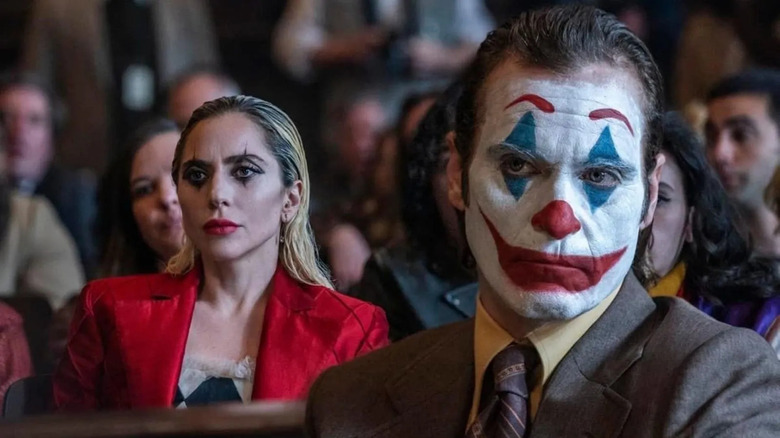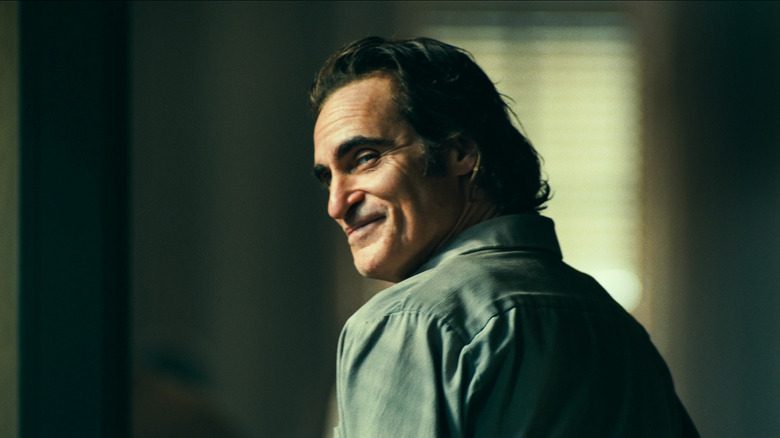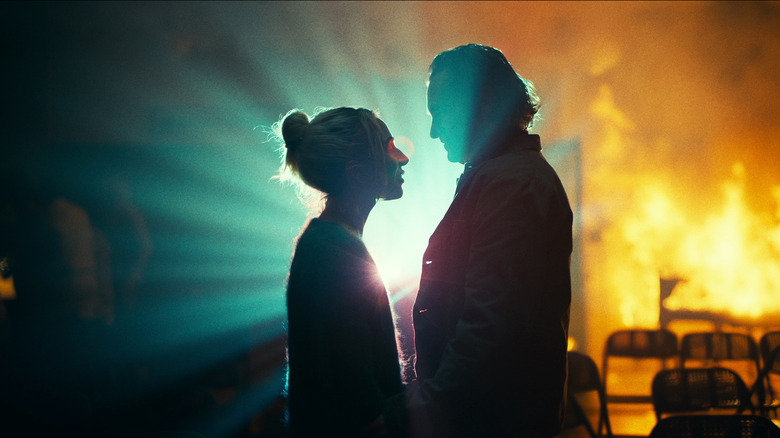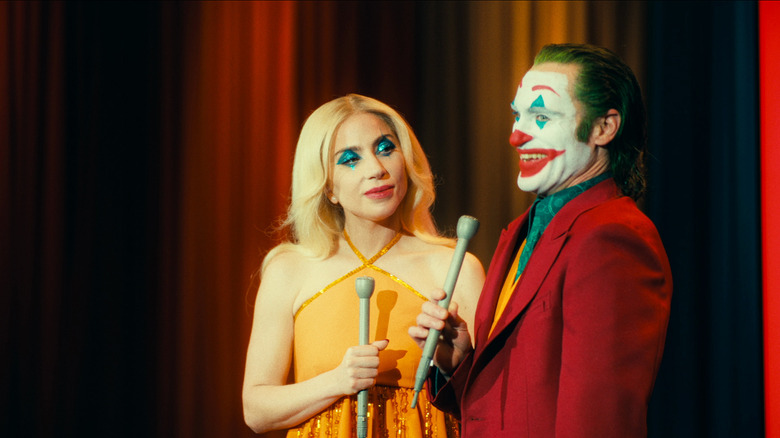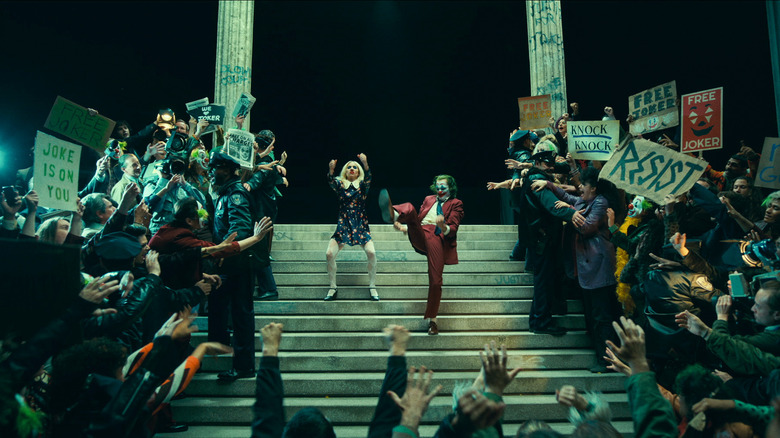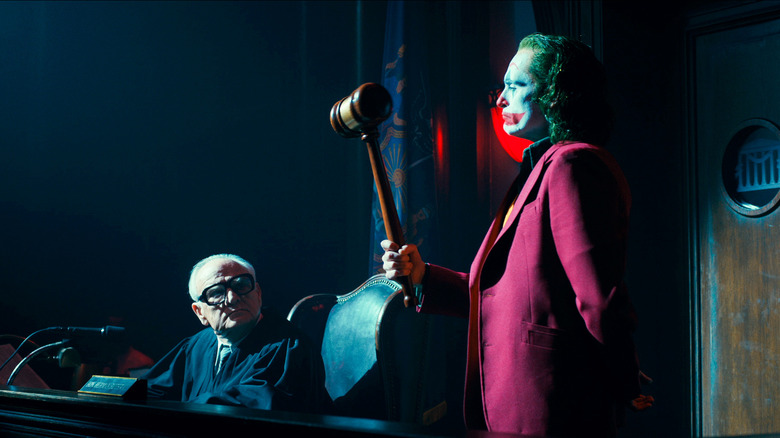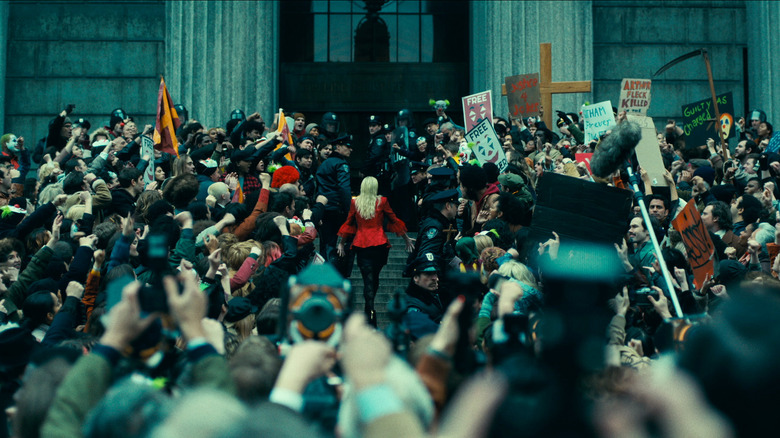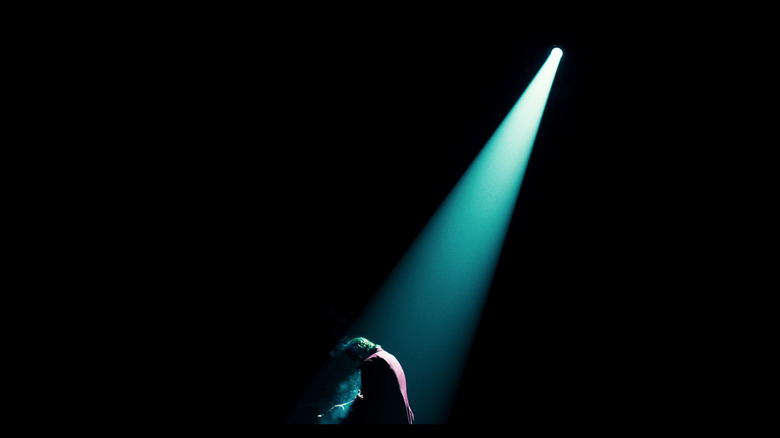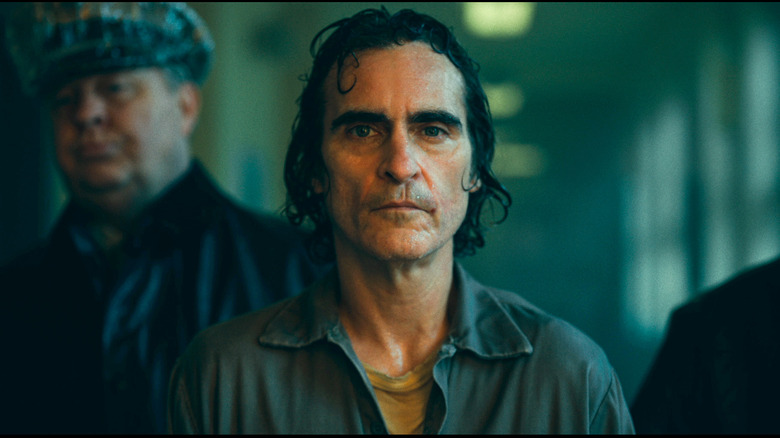The Ending Of Joker 2 Explained: One Bad Joke
MASSIVE spoilers for "Joker: Folie à Deux" ahead.
The Joker is a character that people and pop culture seem to find endlessly fascinating. This is primarily because he's always been portrayed as an unsolvable mystery, with his origins, motivations, interests and behavior never being completely understood or predictable. People are drawn to mystery and ambiguity like moths to a flame, filled with a desperate need to know the unknowable, to tame the untamable. If, however, this mysterious figure proves resilient and refuses to be labeled as "definitive," then people obsessed with them will begin filling the gaps they encounter with what they wish that figure to be. Until, eventually, there's nothing left of the figure itself; it's become the beholder.
That description could apply to almost any public figure in the real world, not just Joker, which is why it's one of the major themes in "Joker: Folie à Deux." The film directly follows 2019's "Joker," which saw director/co-writer Todd Phillips, co-writer Scott Silver, and star Joaquin Phoenix take a very Martin Scorsese-flavored character study look at the man who would be Joker, Arthur Fleck. That movie is a bit of a hat trick, a way for Phillips to smuggle in a dark, R-rated, studio-funded character drama with the comic book IP trappings, along with a way to explore the concept of the Joker character from an angle that's not beholden to any pre-existing cinematic universe or franchise. Even the fact that Joker has been traditionally very open to interpretation when it comes to his origin story works in the movie's favor; it's about The Joker and This Joker simultaneously.
"Folie à Deux" is a direct continuation of that film, from its aesthetics to its world building. The biggest difference is that, where "Joker" was a story of a broken society encroaching upon and shaping an unstable man into something dangerous, "Folie à Deux" inverts that dynamic. It takes a look at how the "Joker" persona and myth eclipses the man who gave it life, so much so that he starts to not recognize it (or himself) any more, especially when he makes a real connection with another person who only encourages and love him for that persona. "Folie à Deux" is a movie so emotionally fraught, of course it had to be a musical. It's also an early indication the film is one long, mean joke: on Arthur, and on us.
Arthur Fleck's Merrie Melodies
"Joker: Folie à Deux" begins with an Old Hollywood flourish: an opening cartoon that briefly recaps the first film, especially when Joker/Arthur (Phoenix) murders talk show host Murray Franklin (Robert De Niro) live on the air. Except, this cartoon presents the idea that Joker and Arthur are not necessarily the same person, with the "Joker" persona being largely responsible for getting poor Arthur into trouble. Is this something Arthur actually believes after two years of being in maximum security confinement within Arkham State Hospital? That's up for debate.
There's no denying that Arthur has lost his mojo since we saw him last, though, as he shuffles through his daily life, taking his medication with nary a smile, let alone an outburst of laughter. It wasn't always like this, it seems, as the head guard, Jackie Sullivan (Brendan Gleeson), relentlessly taunts Arthur by trying to get him to tell everyone a joke. Still, there appears to still be an inner fantasy life within Arthur, as a temporary transfer between maximum and minimum security wards to visit his lawyer, Maryanne Stewart (Catherine Keener), sees him fantasize that the umbrellas the guards are carrying are all multicolored.
While Maryanne is optimistic about Arthur's upcoming trial for the murder of Murray and the Wayne Enterprises employees on the subway from the first film (the potential murder of an Arkham employee, as hinted at in the first film's final scene, may have indeed been a hallucination), she's filling him with the idea that "Joker" is simply a disordered and distinct personality from Arthur, which makes his crimes not guilty by reason of insanity. This explanation doesn't make Arthur feel any less persecuted or confused, however, especially when he locks eyes with a woman singing in a music therapy class. Given Jackie's penchant for singing around the jail — particularly "When the Saints Go Marching In" — it doesn't take much for Arthur to cash in his good boy chips and convince the guard to let him attend music class the next day.
Joker and Harley build a mountain of their love
A skeptical Arthur finally meets Lee (Lady Gaga), a woman who instantly professes herself as a huge Joker stan. Arthur is, of course, correct to be skeptical, having once hallucinated an entire loving relationship between himself and his old next door neighbor, Sophie Dumond (Zazie Beetz). Yet Lee appears to be the real deal, as she tells Arthur she used to live in his old neighborhood, that she once committed arson in her childhood home, that her parents are either dead or absent, and most importantly, that she's watched the TV movie about Arthur/Joker at least 20 times. Arthur has never seen it, and just wants to know if it was good. Lee assures him it was.
Following the duo's brief duet of Judy Garland's "Get Happy," Arthur returns to maximum security, seeing a program about his impending trial on television. It's here that his fantasy life reemerges, his budding feelings for Lee resulting in a hallucinated rendition of Stevie Wonder's "For Once In My Life." Later, as the combined patients of Arkham are treated to a movie (1953's "The Band Wagon," its use a companion piece to Arthur watching the 1937 Fred Astaire/Ginger Rogers musical "Shall We Dance" in the first film), Lee impulsively sets fire to a nearby piano, causing a riot that allows her and Arthur to escape outside. While singing a rendition of "That's Entertainment," Lee and Arthur attempt to flee Arkham, almost running into the eager arms of the Joker fans protesting outside the gates, but are recaptured instead.
However, only Arthur is thrown into solitary confinement, while Lee is not only discharged, but is also allowed to visit Arthur in his cell. Lee (whose full name is Harleen) promises Arthur they are "gonna build a mountain" of their love (a reference to a Sammy Davis Jr. song), but she needs him to embrace his true Joker persona, going so far as to bring him makeup to put on before the two consummate their relationship in that cell.
A song in Arthur's heart gets it broken
Arthur being encouraged by Lee to embrace his Joker persona only makes the Joker's trial more attractive to both the media and the manic. Initially, Arthur is still persuaded by Maryanne to stick to the idea that "Arthur" and "Joker" are two separate personalities. She attempts to coach him on that point during a big televised interview with a maverick journalist, Paddy Meyers (Steve Coogan), but Paddy's crossing the line during the interview prompts Arthur to burst into song on the air in a performance largely intended for Lee (who is dutifully watching the broadcast outside an electronics shop in Gotham).
As the trial begins, Maryanne's ability to control Arthur is challenged, especially as prosecuting attorney Harvey Dent (Harry Lawtey) is adamant that Arthur and Joker are one and the same. Maryanne isn't merely trying to bend the truth to win the case, however; she seems to genuinely want to draw attention to Arthur's abusive childhood while also proving he's a human being, unlike the increasingly monolithic "Joker" persona. In the spirit of wanting to help Arthur, Maryanne reveals an uncomfortable truth: Lee's been lying to him ever since they met. She's actually from a wealthy family, her parents are very much alive, and she was self-admitted to Arkham (having committed to no crimes) and thus discharged herself when she wanted to, having only gone there to get close to the Joker. Upon learning this, Arthur hallucinates a '70s-style variety show hosted by himself and Harley that ends with Harley shooting him in the gut.
Arthur and Lee are lovers on the run — from themselves
Much of "Folie à Deux" presents Joker and Harley as the "criminal lovers on the run" trope ( à la "Bonnie & Clyde," "Love Lies Bleeding," etc.). Phillips and Silver even add some "People vs. Larry Flynt" into the mix with the film's courtroom drama, plus a bit of "Midnight Express" in the scene when Lee visits Arthur in one of those call box glass booths. Arthur is once again confused and uncertain; after hallucinating a relationship in the first film, he's worried the real relationship he has now is a lie. Lee reassures him that, despite her fabrications, her love and their love is real. Lee then drops a bombshell on Joker — their carnal encounter in solitary has left her pregnant — before following this revelation with a rendition of the Carpenters' "Close to You."
This is all Arthur needs to not only commit to Lee even harder than before, but also to fully embrace his Joker persona. He starts showing up to court dressed as the Joker, fires Maryanne, and insists on representing himself. It's here that he (and possibly Harley) has a fantasy hallucination where the couple take over the court and make it into a spectacle of irreverent violence, ending with Joker banging the judge to death with his own gavel. Arguably, this sequence is where the film comes closest to feeling like the comic books (even vaguely recalling the Joker-esque elements of the '90s "Flash" TV series' final episode, "The Trial of the Trickster"). For all intents and purposes, this is what "Joker" fans looking for a "Joker on trial" story signed up for: anarchy, mayhem, and murder.
Arthur's past returns to haunt him
However, it's at that point the fun stops, as Arthur's sordid past literally returns when the people he's wronged take the witness stand. First up is Sophie, who reveals her perspective of the events of "Joker" (which does the double duty of making her a fully-fledged character, as opposed to Arthur's fantasy version of her). Next, poor Gary Puddles (Leigh Gill), the man who worked with Arthur at the clowns-for-hire agency, gets on the stand and describes having to witness the horrible sight of Arthur murdering their co-worker in cold blood.
Despite Joker protesting that he always liked Gary, and that Gary had nothing to fear given that Joker was only killing people he believed deserved it, Gary explains that Joker's actions elicited fear whether he intended them to or not. This throws Arthur for a loop; in his deluded mind, his actions of anarchic violence were revenge on an unjust society and people who represent it. If he's actually a part of the disease and not the cure, as he'd hoped, then what does that make the Joker?
This new outlook only continues once Arthur returns to maximum security. A riled-up faction of inmates incites a prison riot by singing "When the Saints Go Marching In," much to the fury of Jackie and his fellow guards. Jackie and the guards corner Arthur in the bathroom, leading to a moment that quotes another cinematic milestone, "The Shawshank Redemption," in which Arthur is brutally assaulted by the group. It seems that embracing the Joker is only leading Arthur to deeper depths of despair.
As such, Arthur appears once again as himself in court during the closing statements. In delivering his to the jury, Arthur admits to his wrongdoing and explains that there is not and never was a "Joker," just Arthur. At this, Lee stands up and marches out, having dolled herself up in full Harley Quinn garb for the occasion. Understanding that he's offended his love, Arthur makes a phone call to her afterward, leaving a long answering machine message and pleading with her to return while singing her a song. Lee listens to the message as it happens, slowly lifting a gun to her own temple. The next day, the jury reveals its verdict: Arthur is guilty on all counts.
Arthur picks through the ruins of Joker
Just then, an explosion rocks the courthouse, blowing a huge hole in the side of the building. Arthur struggles through the rubble to make it outside, yet no one's around to take credit; it's just the anarchy Joker has encouraged made manifest. As he wanders down the street, Arthur is recognized by a fan in Joker makeup, who insists Arthur join him and his friend in their car. As the trio make their getaway, it's clear this is the movie's version of Joker's gang of henchmen. Of course, this Gotham and its Joker are far less archetypal than in the comics, and Arthur wants nothing to do with these so-called fans, escaping at the first opportunity and returning to the steps by his old apartment.
He discovers Lee there, who is still alive and still wearing her Harley Quinn getup. Arthur is glad that the two can finally be together as he so desperately wants to be, but Lee rejects him, telling him that it was only Joker that she was in love with, and Arthur killed him. Arthur asks about the pregnancy, but Lee doesn't give him an answer, indicating this was yet another lie on her part, a way she could continue to manipulate Arthur and manufacture the version of the man she wanted. In this fashion, "Folie à Deux" is a gender-swapped "Vertigo," with Harley in the Jimmy Stewart role. Lee tells Arthur goodbye, leaving him alone and despondent as a flurry of police cars arrive.
Arthur gets the punchline
Some time later, Arthur is still incarcerated in Arkham, when he's informed by Jackie that a visitor has come to see him. Before he can get to the visitor's area to see who it is, another inmate corners him in the hallway, insisting on telling him a joke before he goes. Arthur, who's returned to where he was at the beginning of the film, not smiling or laughing, begrudgingly tells the man to make it quick. The man begins, telling a joke about a psychopath meeting an old clown who he used to be a fan of at a bar. The clown is all washed up, a drunk loser, but the psycho offers to buy him a drink anyway, asking the clown what he'll have. "I'll have anything if you're buying," the clown says. "You'll get what you f***ing deserve," the psycho says, and at that, the man stabs Arthur with a shiv multiple times.
The fateful last words Arthur had said to Murray Franklin ring in his ears as he begins to bleed out, leading to a final fantasy hallucination and musical number, wherein Joker sings a solo after having been shot in the gut by Harley during their variety show. Back in reality, Arthur dies in the Arkham hallway while, out of focus in the background, the man who stabbed him laughs uncontrollably as he uses the shiv to carve a permanent smile on his face. The joke is on Arthur: his monstrous, murderous nature created a sick folk antihero that grew past and apart from him. His shadow became powerful enough to not only outlive him, but seemingly is now able to be harnessed and exploited by other people, too.
For Joker, that's life
The joke isn't just on Arthur, however, because it's also on us: for these two movies, we thought we were watching the Joker, but it turns out that he was just a Joker. Sure, it's clear that in this version of Gotham City, Arthur and his exploits created the "Joker" persona where it didn't previously exist, but as the ending infers, Arthur is not the person who meets a grown-up Bruce Wayne in his guise as the Dark Knight. Furthermore, we can't even be 100% certain that the man we see murder Arthur and take on the Joker mantle is going to be Batman's Joker, either. If the Joker persona is something viral, an identity that any deviant person can adopt, then "Joker" and "Folie à Deux" go beyond a mere Elseworlds-esque origin story for the character as a person; these are movies that are an origin story for the very concept of a Joker.
In the Batman comics and most cinematic adaptations, so many of the characters (Batman very much included) find themselves transformed via a trigger event, whether it's the brutal murder of loved ones or getting dunked in acid. The "Joker" films focus instead on the environment of Gotham and society at large leading inevitably to such trigger events, to the point where these events seem less destined and more random. It takes the latent idea behind Batman — that he's a superhero who most average people could become, if they had the means and motivation — and flips it on his head. Anyone could become the Joker.
While Arthur's demeaning demise is a cruel trick of fate that can engender feelings of empathy for him, it's important to remember that he brought it on himself. Not just morally, with his acts of brutalization and murder, but also metaphorically: in "killing" his Joker side and eradicating his "shadow," he got rid of the person Lee loved and so many others idolized. Arthur as Old Hollywood musical romantic lead and Arthur the tragic victim are, crucially, both identities that exist only in his mind. In reality, Arthur leans closer to someone like James Cagney's Cody from "White Heat." Or maybe not even someone with that much integrity; he's just another Murray Franklin, a flashy public persona whom people like Arthur build up in their minds.
"Folie à Deux" has its cake and eats it too, acknowledging the power and popularity of the Joker while bursting the bubble of the character: he could be anybody, but he's really nobody. We'd do well to heed that lesson while reckoning with our own shadow selves, lest we become the butt of life's joke, too.
